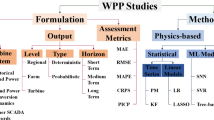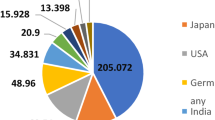Abstract
In this paper, the model based on a feed-forward artificial neural network optimized by particle swarm optimization (HGAPSO) to estimate the power of the solar stirling heat engine is proposed. Particle swarm optimization is used to decide the initial weights of the neural network. The HGAPSO-ANN model is applied to predict the power of the solar stirling heat engine which data set reported in literature of china. The performance of the HGAPSO-ANN model is compared with experimental output data. The results demonstrate the effectiveness of the HGAPSO-ANN model.







Similar content being viewed by others
Abbreviations
- C V :
-
Specific heat capacity, J mol−1 K−1
- h :
-
Heat transfer coefficient, WK−1 or WK−4 or Wm−2 K−1
- n :
-
The mole number of the working fluid, mol
- M :
-
Regenerative time constant, Ks−1
- p :
-
Power, W
- Q :
-
Heat transfer, J
- R :
-
The gas constant, J mol−1 K−1
- t :
-
Time, s
- T :
-
Temperature, K
- W :
-
Work, J
- λ :
-
Ratio of volume during the regenerative processes
- τ :
-
Cyclic period, s
- η :
-
Thermal efficiency
- k 0 :
-
Heat leak coefficient, WK−1
- ɛ R :
-
Effectiveness of the regenerator
- H:
-
Absorber
- HC:
-
High temperature side convection
- HR:
-
High temperature side radiation
- L:
-
Heat sink
- LC:
-
Low temperature side convection
- m:
-
The system
- R:
-
Regenerator
- t:
-
Stirling engine
- 0:
-
Ambient or optics
- 4-1:
-
The processes
References
Thomas M, Peter H (2003) Dish-stirling systems: an overview development and status. J solar Energy Eng 125:135–151
Thombare DG, Verma SK (2008) Technological development in the stirling cycle engines. Renew Sustain Energy Rev 12:1–38
Luo YJ, He XN, Wang CG (2005) Solar application technology. Chemical Industry Press, Beijing, pp 253–271
Rallo R, Ferre-Gin J, Arenas A, Giralt F (2002) Neural virtual sensor for the inferential prediction of product quality from process variables. Comput Chem Eng 26:1735–1754
Yaqi Li, Yaling He, Weiwei Wang (2011) Optimization of Solar-powered stirling heat engine with finite-time thermodynamics. Renewable Energy 36:421–427
Kim J-S, Kang YH (2006) Progress of R& D efforts for solar thermal power generation in Sout Korea. SolarPACES 13th international symposium, June 20–23 seville Spain, IEA SolarPACES
Wu F, Chen LG, Sun FR et al (2008) Performance optimization of stirling engine and cooler based on finite-time thermodynamic. Chemical Industry Press, Beijing, p 59
Costea M, Petrescu S, Harman C (1999) The effect of irreversibility’s on solar stirling engine cycle performance. Energy Convers Manage 40:1723–1731
Kaushik SC, Kumar S (2000) Finite time thermodynamic analysis of end reversible stirling heat engine with regenerative losses. Energy 25:989–1003
Kaushik SC, Kumar S (2001) Finite time thermodynamic evaluation of irreversible Ericsson and stirling heat engines. Energy Convers Manage 42:295–312
Ahmet D, Oguz SS, Bahri S, Hasbi Y (2004) Optimization of thermal systems based on finite-time thermodynamics and thermo economics. Prog Energy Combust Sci 30:175–271
Hornik K, Stinchcombe M, White H (1990) Universal approximation of an unknown mapping and its derivatives using multilayer feed forward networks. Neural Net w 3(5):551–560
Garcia-Pedrajas N, Hervas-Martinez C, Munoz-Perez J, COVNET (2003) A cooperative co-evolutionary model for evolving artificial neural networks. IEEE Trans Neural Netw 14:575–596
Brown M, Harris C (1994) Neural fuzzy adaptive modeling and control. Prentice-Hall, Englewood Cliffs
Eberhart RC, Kennedy J (1995) A new optimizer using particle swarm theory. In: Proceedings of the 6th international symposium on micro machine and human science. Nagoya, Japan, pp 39–432
Eberhart RC, Simpson PK, Dobbins RW (1966) Computational intelligent PC tools. Academic Press Professional, Boston
Shi YH, Eberhart RC (1998) A modified particle swarm optimizer. In: Proceedings of IEEE world conference on computation intelligence, pp 69–73
Rechenberg I (1994) Evolution strategy, in computational intelligence: imitating life. IEEE Press, Piscataway
Schwefel HP (1995) Evolution and optimum seeking. Wiley, New York
Holland JH (1975) Adaptation in natural and artificial systems. University of Michigan Press, Ann Arbor
Hassan R, Cohanim B, Weck O (2005) A comparison of particle swarm optimization and the genetic algorithm. In: Proceedings of 46th AIAA/ASME/ASCE/AHS/ASC structures, structural dynamics & materials conference, Austin, Texas, pp 18–21
Juang CF (2004) A hybrid of genetic algorithm and particle swarm optimization for recurrent network design. IEEE Trans Syst Man Cybern B Cybern 34(2):997–1006
Author information
Authors and Affiliations
Corresponding author
Rights and permissions
About this article
Cite this article
Ahmadi, M.H., Sorouri Ghare Aghaj, S. & Nazeri, A. Prediction of power in solar stirling heat engine by using neural network based on hybrid genetic algorithm and particle swarm optimization. Neural Comput & Applic 22, 1141–1150 (2013). https://doi.org/10.1007/s00521-012-0880-y
Received:
Accepted:
Published:
Issue Date:
DOI: https://doi.org/10.1007/s00521-012-0880-y




